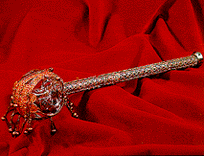The Hungarian
Coronation Jewels
THE SCEPTRE -
The crystal sphere has three figures of crouching lions cut in it, and it is thought that it was made in the 10th century in Egypt, during the reign of the Fatimida kings. On the top of the clamps holding the crystal sphere, a magic knot is placed which is a common sign in the Byzantine mythology to prevent from trouble, and such are the little balls clinging small golden chains which, with their jingling sound kept the vicious spirits away. The present Hungarian regal orb was made during the reign of king Bela III. (1173-1196) and it is unique in its nature because the western kingdoms never used sceptres with a mace-like design. In the west, a cross or a lily ornament was commonly used, and sceptres similar to the Hungarian one in style were recorded from the era of the Persian kings. It was taken over from Persia by the nomadic Avar hordes who wandered and eventually settled in Transylvania. This explains the fact that excavations of Avar graves in Hungary today, the archaeologists found bone-spheres pinned on the tip of handles which resembled a mace.
|
 |
On next page:
4. The Orb
The power, the authority, the jurisdiction
The sceptre symbolized the power, the authority, the jurisdiction of the kingdom. The Hungarian coronation sceptre is an ancient type which rather reminds of a weapon (i.e. mace) than a sign of royalty. The head is made of a crystal sphere which is 7 centimetre (2.75 inches) in diameter and according to our present knowledge, it is the third largest hole-drilled crystal in the world.

It is held in a setting which consists of three golden clamps covered with filigree ornaments made of gilded silver wires. The crystal is mounted on the top of a hazel handle also covered with gilded silver wire ornaments.
|





